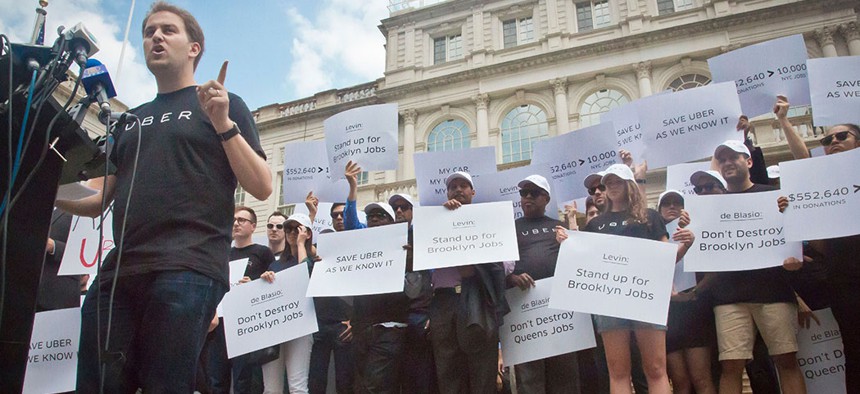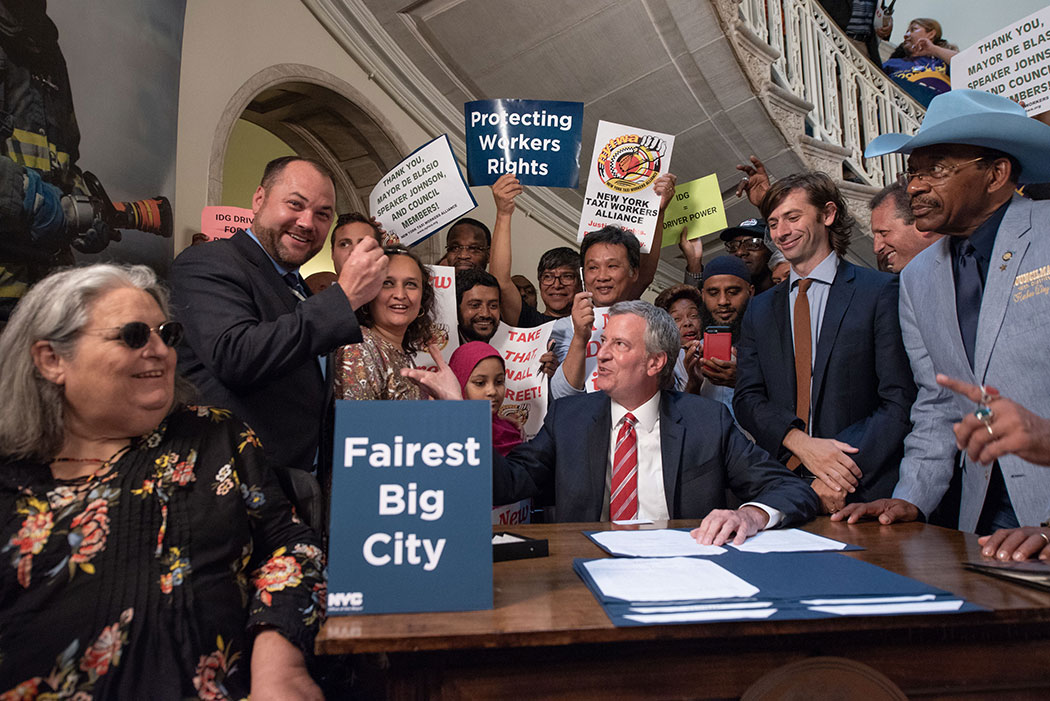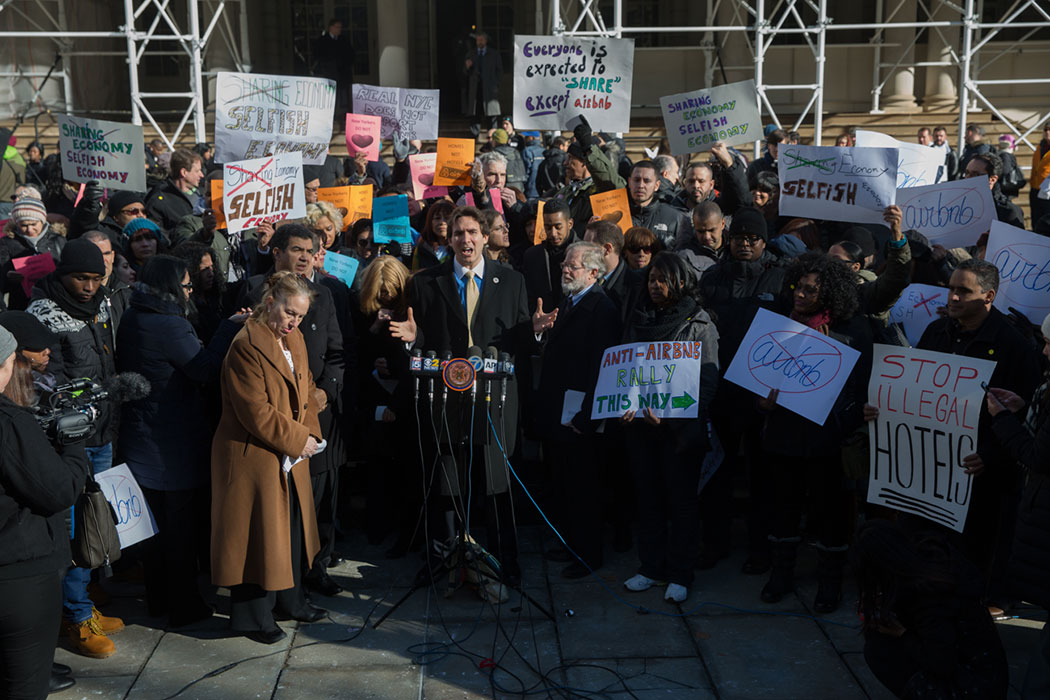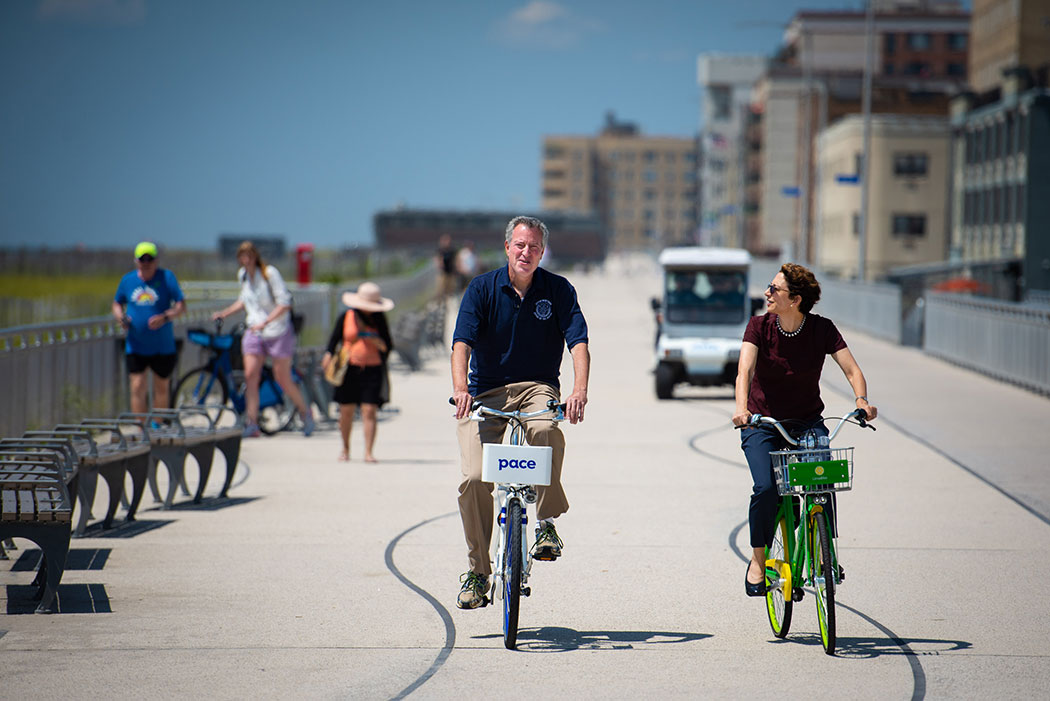New York City Council
The rise and fall of the asshole startup
The days of tech startups slipping into residents’ daily lives unnoticed are over since New York has witnessed the power of companies like Uber and Airbnb,

Josh Mohrer, then Uber's New York manager, led a rally in front of City Hall in 2015 while the council considered a cap on for-hire vehicles. Bebeto Matthews/AP/Shutterstock
Josh Mohrer was on Long Island talking about launching Uber in Nassau County when he first heard that the New York City Council was going to propose a cap on his company’s vehicles. “I got a call from our lobbyist saying, ‘The City Council’s about to propose this thing, it’s definitely going to pass, you’re definitely going to lose,’” Mohrer recalled.
That was in the early summer of 2015, back when daily trips using ride-hailing apps in New York City were still outnumbered by yellow taxi rides by a ratio of 4-to-1, but were on their way to surpassing taxi rides – something that would happen by the end of 2016.While competitors Lyft and Via were already on the scene by July 2015, Uber’s share of the ride-hailing market still hovered around 90 percent, clocking more than 100,000 trips per day. Summoning a car with a smartphone meant one thing to most New Yorkers: calling an Uber.
At the time, Mohrer was the general manager of Uber New York and the de facto face of all its skirmishes with City Hall, which came to a head when Mayor Bill de Blasio and his allies in the City Council proposed the cap on new for-hire vehicle licenses while the city conducted a study on the effect of for-hire vehicles on congestion.
“We sort of sprung into action, like this is bad,” Mohrer said. “This would really end the business. At that point, we’re doing about half a million rides a week, and it kind of felt like there was (an) opportunity to make it much bigger. To not be able to have new vehicles would be a big problem.”
The vehicle cap ultimately didn’t pass that summer, striking a decisive win for the company that paved the way for its rapid growth. In July 2015, de Blasio dropped the proposed cap after growing dissent from City Council members and Gov. Andrew Cuomo. At that time, roughly 21,000 unique vehicles were associated with Uber. By the end of 2018, that figure more than tripled to roughly 77,000.
But last year, a cap on new licenses for app-based ride-hailing vehicles passed in the New York City Council as part of a package of other bills regulating the ride-hailing industry, including a new minimum pay rate for drivers. The measure imposed a moratorium on new for-hire vehicles for one year while the city studies ride-hailing vehicles – which now number more than 100,000 – and their effect on traffic congestion.

Several things have changed since Uber’s early years in New York, including its launch in the city in 2011 and its successful fight against a potentially damaging cap in 2015. Uber and other ride-hailing apps have now overtaken taxis, and cars associated with the apps are increasingly blamed for exacerbating congestion. Uber, still dominant among its competitors, bears more of the blame than others. New York regulators are also taking startups like Uber and Airbnb more seriously now because of their ability to disrupt established industries.
But Uber itself has also changed since 2011 – and even since 2015. Still led by Travis Kalanick in 2015, Uber was a company riddled with sexual assault and price-surging scandals, and whose approach to political resistance in New York was to launch a feature called “de Blasio’s Uber” on the app, which showed the 25-minute wait times riders would endure if the cap passed. Kalanick, famously a fan of Ayn Rand, summed up Uber’s ethos in a 2013 interview with The Wall Street Journal as a company that asked for neither permission nor forgiveness. “We don’t have to beg for forgiveness because we are legal,” he said. “But there’s been so much corruption and so much cronyism in the taxi industry and so much regulatory capture that if you ask permission upfront for something that’s already legal, you’ll never get it. There’s no upside to them.”
Today – after facing increasing pressure from regulators and lawmakers, resulting in a package of regulations passed for app-based services last summer – Uber is discovering that it can’t get away with that approach anymore. Under the leadership of CEO Dara Khosrowshahi, Uber is trying to be a kinder version of its old self. “We think Uber and the cities we operate in have a lot of shared goals, and although it may take compromise and concessions, ultimately working together can get us to those shared goals faster,” Uber spokesman Harry Hartfield wrote in an email.
“It used to be that you could build a company in a vacuum, where regulators weren’t really paying attention, until it was huge. Those days are done.” – Julie Samuels, Tech:NYC executive director
For both established companies and new startups, the question of how best to work with regulators is paramount, especially for tech companies with a mind to disrupt entrenched industries. While there may not be a universal strategy, what seems clear is that there’s no room to replicate early Uber’sirreverent, even combative, approach.
“This is something that works once,” said Bruce Schaller, a transportation policy expert and former deputy commissioner at the New York City Department of Transportation. “Everyone gets wise to it.”
Julie Samuels, executive director of the industry group Tech:NYC, agreed. “It used to be that you could build a company in a vacuum, that you could build a huge network around that company in a vacuum, where regulators weren’t really paying attention, where competitors weren’t really paying attention, until it was huge,” she said. “Those days are done.”
Uber’s reputation for causing trouble began with its 2011 launch in New York City. “In New York, they opened up shop without getting the proper licensing approvals,” Schaller said. Mohrer, however, said the company did abide by the regulations and obtained the necessary licenses.With for-hire vehicles, that meant obtaining three types of licenses – a base license, a vehicle license and a driver’s license – from the New York City Taxi and Limousine Commission. “The idea of pre-arranging a ride and not a street-hail and how those things are different – that all already existed,” Mohrer said. “You had your Carmel and Dial 7 and all these companies already operating. We were able to just kind of be part of that. And I think if you ask the commissioners who oversaw us, they’d probably both say that we’re pretty good at following the rules.”
While the taxi commission in some ways welcomed Uber as a transportation alternative at the time, the company continued to break regulations, according to a former city official. In 2012, the commission outlined a number of additional rules that Uber violated, including that customers’ fares weren’t entered into T-PEP, the city system that calculates and records fares, and that drivers were not following a rule banning the operation of electronic communication devices while driving.
“New York was the one place that brought them to heel because every other city, they could say, ‘If you don’t play by our rules, we’ll leave.’” – Bruce Schaller, former New York City deputy transportation commissioner
That year, Uber also moved to expand beyond black car service into an option that would allow riders to hail yellow cabs through the app, without explicit permission from the taxi commission. Uber shut down the unsanctioned beta program called UberTaxi after roughly one month in New York City, saying that roadblocks put in place by the taxi commission had killed the program. Later, however, Uber would participate in a government-sanctioned pilot testing out the same idea.
By 2013,the company’s problems became more political than regulatory. “New York was the one place that brought them to heel because every other city, they could say, ‘If you don’t play by our rules, we’ll leave,’” Schaller said. “And they did, in a number of cases. In New York, because of New York’s market power, they could not do that. And also because of the competence of the city in regulating the for-hire industry.”
By 2015, when the number of vehicles associated with Uber was approaching the number of taxis in New York City, Uber had not only developed a national reputation for being an aggressive company, but it had allowed a thorny relationship to fester with de Blasio, who was feeling pressure from the taxi industry to crack down on the apps.
Standing out from competitors Lyft and Via, Uber had weathered innumerable scandals that ran the gamut from rude, sometimes sexist, behavior from top executives and managers, to outright unethical practices. In New York City, that included employees ordering and canceling rides on competing apps to waste drivers’ time and tracking riders with an aerial view that also showed riders’ locations. The tracking system, known as “God View,” was investigated by then-state Attorney General Eric Schneiderman in 2014, who reached a settlement with the company that required Uber to adopt more comprehensive privacy protections, including encrypting rider geolocation information.
In 2014, Mohrer himself was investigated by the company for using the God View tool to track a BuzzFeed reporter’s location without her knowledge – Mohrer showed the reporter that he was using the tool, but she, like all other riders, was not aware that the company had that tracking ability. Uber said it took “disciplinary action” against Mohrer.
“When Uber was the underdog, it was sympathetic in a specific way, and it’s not the underdog anymore.” – Josh Mohrer, former general manager of Uber New York
Outside of New York, the questionable practices of the company and its top executives have spanned everything from using software to deceive local law enforcement in cities where the company violated local laws to allowing prices to surge during natural disasters.
The lobbying and organizing that the company was able to do in New York in 2015, convincing lawmakers that a cap would hurt largely immigrant Uber drivers, was based on goodwill that Uber no longer had in 2018. The first time around, the company was still hanging on to its reputation as an admirable upstart – even if only by a thin string. By last summer, however, some viewed Uber as the taxi industry’s cause of near-death.
“When Uber was the underdog, it was sympathetic in a specific way, and it’s not the underdog anymore,” said Mohrer, who is now the co-founder of the investing syndicate Moving Capital. While he said the company is largely OK with the new minimum pay standard passed last summer, it’s the passage of the de Blasio-backed cap that Uber objects to – enough to have filed a lawsuit against the city last month to overturn the new law. “It feels vindictive,” Mohrer said. “It’s like revenge.”
The unexpected disruption caused by a company like Uber, and the belated backlash to keep those companies in check, is mirrored by a national conversation about how to reverse the questionable privacy and data practices of all-powerful tech giants like Google, Facebook and Amazon. As those companies attempt to cooperate with the government now that strict regulations are being drafted, some startups are attempting to start off with a government-friendly approach – or hit the reset button – in New York City too.
New York was one of the first cities where people used Airbnb after its founding in 2008, and in that early environment, it was able to slip in relatively unnoticed by policymakers, much in the same way that Uber did in 2011. Airbnb’s head of public policy for the Northeast, Josh Meltzer, said this was due to the company’s small scope and an ill-defined regulatory landscape in New York. New York state’s multiple dwelling law – which forbids most units from being rented out for fewer than 30 days – had yet to be updated to include that provision when Airbnb rentals first started popping up. “The size of the host community was so small, and Airbnb was also really small,” Meltzer said. “I don’t think there was any sense of what the regulatory landscape in New York meant for this startup, effectively.”
Like Uber, Airbnb was then a startup whose potential to disrupt established industries was unknown. “I just don’t think elected officials in 2011 thought that an app for ride-sharing or home-sharing was going to revolutionize industries the way that they have,” Samuels said.
Today, Airbnb’s footprint has expanded to include more than 50,000 listings in New York City, and the company is embroiled in a yearslong battle at both the city and state level to establish a proper regulatory framework. Most recently, Airbnb and competitor HomeAway won an injunction against a New York City law that would require the companies to disclose to city regulators detailed address information about their hosts. Airbnb is fighting a similar bill in Albany sponsored by Assemblywoman Linda Rosenthal and backed by the powerful hotel lobby. As an alternative, the company is pushing a bill it helped write, sponsored by Assemblyman Joseph Lentol, that wouldn’t require that kind of disclosure, but would allow Airbnb to collect the same taxes that hotels usually do, limit hosts in New York to listing one unit on the website and require hosts to register with a state agency.
Meltzer said that the company’s approach to working with the government hadn’t really been formalized until around 2015 – about the same time that he said Airbnb started to feel pressure from the hotel industry. “As the community was growing and growing and bumping up against local, most of the time undefined, regulatory situations, that’s when more of a focus on proactive public policy happened,” he said, drawing a contrast to what he said was previously a reactive approach.
Airbnb’s critics argue that the Lentol bill doesn’t go nearly far enough in protecting the city’s dwindling supply of affordable housing from landlords who use the service to profit by operating illegal hotels. But what’s clear is that after disrupting the hotel industry in much the same way that Uber disrupted taxis,Airbnb sees no benefit in adopting a combative approach to public policy. “A big lesson from all of this is that it’s important to have sustained, meaningful conversations with local elected officials and local community groups,” he said. “I think that general approach is one that any tech company or innovator can successfully apply.”
Instead of mocking de Blasio with a feature on its app, for example, last summer Airbnb donated $10 million to nonprofit organizations as a representation of the $100 million in added annual tax revenue the company said New York would make if its proposed tax collection measure passed the state Legislature. In other words, the company may be spending hundreds of thousands of dollars to push their favored regulations in Albany, but they’re not being jerks about it.

Today, with New York having witnessed the power of companies like Uber and Airbnb, the days of tech startups slipping into residents’ daily lives unnoticed are over. “Now, people take startups very seriously, they understand their potential – both negative and positive, I’d argue – and I think that holds true with regard to regulators, with regard to competitors, with regard to potential users,” Samuels said. “If anything, I would argue, we’ve swung the pendulum in completely the other direction in that people take every idea seriously, which they probably shouldn’t.”
One emerging field that has cultivated a particularly cozy relationship with government is transportation alternatives like e-bikes and e-scooters. Some of the largest e-bike companies are participating in a concentrated pilot program to deploy their dockless bikes – both traditional and pedal-assisted e-bikes – in outer-borough neighborhoods.
With a fight brewing in the New York City Council about legalizing e-scooters and throttle e-bikes – a bike that can move without any pedaling –the behavior of companies participating in the pilot, who ultimately hope to launch their e-scooters or throttle bikes in the city, could be instrumental in changing the minds of holdouts, including de Blasio.
“We’ve been able to stick around and work and grow (by) working with elected officials to get it right.” – Phil Jones, East Coast government affairs senior director of Lime
The New York City Department of Transportation’s pilot program, which began in July 2018, has been extended multiple times, and is now on set to continue through May. The companies still participating include Lime, Jump and Citi Bike. The companies are using both pedal-assisted e-bikes – which were legalized last year and give bicyclists a boost of up to 20 mph – and traditional bikes, but all operate without a docking station. From the start, those companies’ approaches have been government-centric.
“We understand that each neighborhood is unique, so that’s why it’s so important for us to work with the local elected officials, the community groups, the stakeholders who’ve been in these places for decades, because they help us understand how we should be implementing these new forms of transportation,” said Phil Jones, Lime’s East Coast government affairs senior director. Every two weeks, he said, Lime has a conference call with DOT officials to discuss ridership, issues like cluttering and deployment strategies. “Working with the DOT, we were able to really find those places where we needed the e-bikes, worked with them to put them on the ground, and then we’ve seen increased ridership from there,” Jones said. “It’s a two-way street.”
To be sure, dockless bike companies like Lime are not entirely comparable to Uber. For example, if Lime were to launch e-scooters in New York without permission, it would be relatively easy for law enforcement to spot and crack down on the flashy, lime green scooters. It’s also easier to impound an e-bike than it is an Uber car. But Jones said he thinks Lime’s efforts to work with the DOT has put the company ahead of its competitors. “What we’ve found is that we’ve been able to stick around and work and grow in a way that other companies have not because we’ve put so much effort into making sure that the community understands the platforms, that they are a part of our workforce, that they see it as engaging the groups that they care about currently on the ground, and working with those elected officials to get it right,” he said.
This is not just an example of new startups forging a friendlier path than Uber or even Lyft. In some cases, it’s a case of those companies changing themselves. Last summer, Lyft acquired Motivate, Citi Bike’s parent company, and Uber now owns Jump.
“When those companies launched, they didn’t have a single policy person on staff,” Samuels said. “If you were to look at some of the e-bike companies, the scooter companies for sure, my well-informed guess is that they hired policy teams much earlier than it took Uber and Lyft to realize they needed to hire policy teams.”
That a re-energized effort to legalize throttle bikes and e-scooters coincides with the success of pedal-assisted bikes in the dockless pilot program may not be a matter of chance. New York City Council members, including Rafael Espinal Jr. and Fernando Cabrera, are backing a new package of bills to legalize both, and Cuomo’s budget includes categories for both e-bikes and e-scooters and calls on localities to decide whether to authorize the vehicles. “We feel that with the overwhelming support that we are seeing at the City Council, the governor putting micromobility into his fiscal year budget, and the discussions that we’ve been having with our state senators and our state Assembly people, the outlook is good in New York,” Jones said. “We really do feel that scooters and e-bikes will be made available to New Yorkers in the near future.”

It’s hard to say whether a friendlier approach with government – or even with de Blasio – would have prevented Uber and its competitors from being hit with the ride-hailing license cap last summer. After all, had Uber acquiesced to de Blasio’s attempts to install the cap in 2015, it wouldn’t have experienced the massive growth it had in those intervening three years.
“For some companies, in certain industries, a more hard-nosed tactic might be appropriate, and for some companies in other industries, a more kind of compromising tactic might be appropriate,” Samuels said, noting that every New York regulatory agency is different and that the experiences of every startup will vary.
But that Uber is taking a gentler approach today is clear. The company said it is working with the city on regulations, even on provisions it might have once scoffed at. “Congestion and sustainability are great examples. We’ve committed $10 million over the next three years to campaign for sustainable mobility and congestion pricing,” Hartfield, the Uber spokesman, said. “There will continue to be moments where we disagree with regulators, but our hope is that an open and honest dialogue, based on mutual respect, strengthens our ability to have our concerns taken seriously.”
Mohrer called the company’s current ethos “less combative,” though he disagrees with the idea that industry-disrupting startups are being more cautious in New York because Uber is in some way paying for its previously aggressive demeanor. But as policymakers grow more cognizant of the impact these companies can have, common wisdom might say that in New York today, it’s better to ask for permission than forgiveness.
“My instinct would be to work with government where and when possible, and as early as possible,” Samuels said. “That’s not a blanket prescription. That’s, to my mind, the starting point.”
NEXT STORY: Tech’s footprint in Hudson Yards

